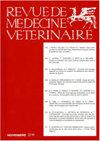中美洲貘(Tapirus bairdii)下颌炎症
Q2 Veterinary
引用次数: 0
摘要
bairdii(貘),也被称为danta,生活在热带森林,低山林,落叶林,被洪水淹没的草甸和湿地。貘的内部解剖结构类似于驯养的马,就像它的牙齿配方一样。磨牙缺乏骨水泥,牙冠小或低,是完全的牙齿。在圈养收集的貘中,下颌炎症是非常常见的,其病因和患病率已经讨论过,但尚未定义。这项工作表明,改变出牙和保留牙冠“帽”可能是颌骨炎症的病因,这是基于它的对应物马,它在生理上应对以下过程:作为永久性*本文章由计算机程序翻译,如有差异,请以英文原文为准。
Inflamación mandibular en el tapir centroamericano (Tapirus bairdii)
Baird's tapir (Tapirus bairdii), also known as danta, inhabits tropical forests, lower mountain forests, deciduous forests, f looded meadows and wetlands. The internal anatomy of the tapir is analogous to the domestic horse, as is its dental formula. Molars lack cement and have small or low crowns, being fully lofodonts. Mandibular inf lammation in tapirs is very common in captive collections and their etiology and prevalence have been discussed, but have not been defined. This work suggests changing teething and retaining the crown “caps” as a possible etiology of jaw inf lammation based on its counterpart the horse, which physiologically copes with the following process: as permanent *
求助全文
通过发布文献求助,成功后即可免费获取论文全文。
去求助
来源期刊

Revue De Medecine Veterinaire
农林科学-兽医学
CiteScore
1.30
自引率
0.00%
发文量
0
审稿时长
18-36 weeks
期刊介绍:
The Revue de Médecine Vétérinaire publishes four kinds of text:
1) Scientific reviews on subjects related to veterinary and comparative medicine. Suggested length: 10 to 30 typed pages.
2) Original reports on fundamental or applied research. Suggested length: 10 to 15 typed pages.
3) Continuous education articles, that should be easily understandable by non-specialists. Suggested length: 10 to 15 typed pages.
4) Clinical reports. Suggested length: 5 to 15 typed pages.
The publication can be done in French language or English language.
For an article written in English by not english native speakers authors, the manuscript must be subjected by attesting that it was read again by an anglophone scientist or a scientific translator.
The authors must certify that the manuscript was not published or subjected for publication to another review.
The manuscript must be accompanied by a sheet signed by all the joint authors indicating their agreement for the tender of the manuscript.
The publication is free but a financial participation could be required for the photographs color. An estimate will be sent to collect the agreement of the authors.
 求助内容:
求助内容: 应助结果提醒方式:
应助结果提醒方式:


